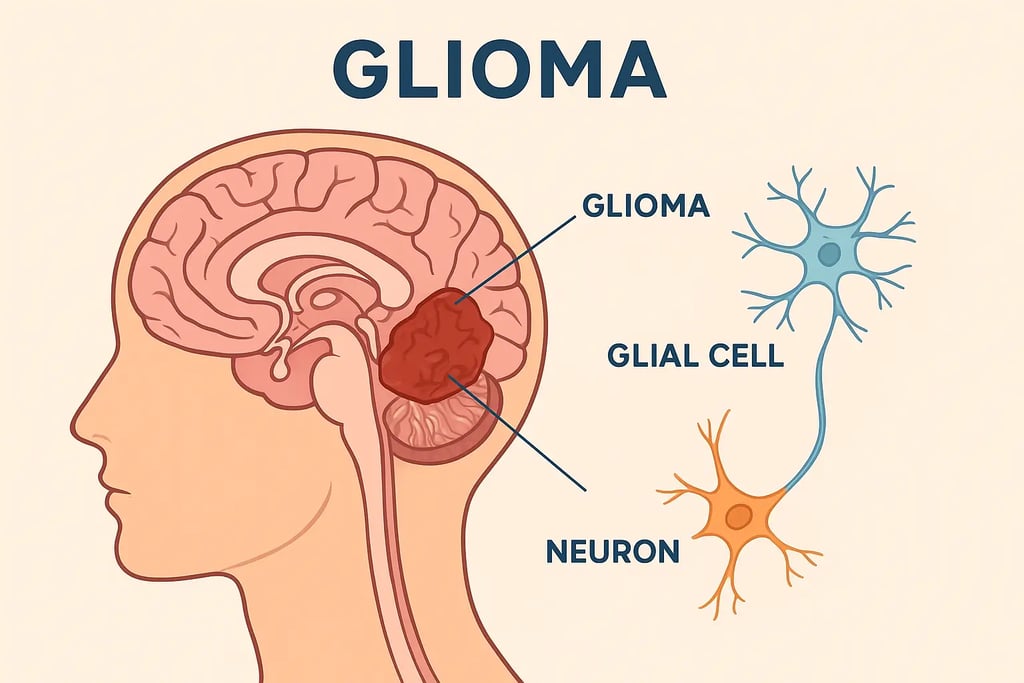What is Glioma? Causes, Symptoms, and Treatment Options
Learn what glioma is, its causes, symptoms, and treatment options. Understand different types of gliomas like astrocytoma, oligodendroglioma, and ependymoma, and how they affect brain health.


Introduction: Understanding Glioma
Glioma is a type of brain or spinal cord tumor that originates from glial cells—the supportive cells of the nervous system that help neurons function efficiently. These tumors vary widely in behavior, from slow-growing and benign to aggressive and life-threatening.
Gliomas are classified based on the type of glial cell they develop from. The main types include:
Astrocytomas: Tumors that form from star-shaped glial cells called astrocytes. They range from low-grade (slow-growing) to high-grade (fast-spreading and aggressive).
Oligodendrogliomas: Arise from oligodendrocytes, the cells responsible for forming the myelin sheath that insulates nerve fibers. These usually grow more slowly and respond better to treatment.
Ependymomas: Develop from ependymal cells that line the brain’s ventricles and the spinal canal. They can occur at any grade and often require precise, individualized treatment.
Gliomas are graded on a scale from Grade I (least aggressive) to Grade IV (most aggressive). This grading system helps doctors determine the tumor’s behavior, treatment options, and prognosis.
Because gliomas make up a large percentage of all brain tumors, understanding their nature is crucial. They can significantly affect neurological functions, leading to seizures, memory loss, or motor difficulties. Early detection and accurate diagnosis can improve treatment outcomes and quality of life.
Causes of Glioma
The exact cause of glioma is not fully understood, but research has identified several genetic and environmental factors that may increase risk.
1. Genetic Factors
Some people inherit genetic conditions that increase their susceptibility to gliomas, such as:
Neurofibromatosis type 1 (NF1)
Li-Fraumeni syndrome
Mutations in genes like TP53 and IDH1, which influence cell growth and DNA repair.
These findings highlight the role of genetic predisposition and encourage genetic screening in families with a history of brain tumors.
2. Environmental Exposures
Exposure to ionizing radiation, particularly from previous medical treatments or radiation therapy, has been linked to a higher risk of developing gliomas.
Some studies also suggest a possible link between chemical exposure (such as pesticides and industrial solvents) and glioma risk, though more research is needed to confirm this connection.
3. Age and Gender
Gliomas are most commonly diagnosed in adults aged 45–65 years and occur slightly more often in men than women, suggesting possible hormonal or biological influences.
Overall, while no single factor directly causes glioma, a combination of genetic mutations, environmental factors, and biological variables likely contributes to its development. Continued research is vital to better understand and prevent this disease.
Symptoms of Glioma
The symptoms of glioma depend largely on the tumor’s location, size, and rate of growth. Because these tumors can affect vital areas of the brain, they often produce noticeable neurological changes.
Common glioma symptoms include:
Persistent headaches that worsen over time or differ from typical headaches.
Seizures, even in individuals with no previous history.
Cognitive and behavioral changes, such as memory loss, confusion, personality changes, or poor concentration.
Motor dysfunction, including weakness on one side of the body, loss of coordination, or altered reflexes.
Speech difficulties or vision problems if the tumor affects related brain areas.
Recognizing these early symptoms is crucial for timely diagnosis. If these signs persist, medical evaluation—including imaging tests like MRI or CT scans—is recommended.
Treatment Options for Glioma
Glioma treatment is tailored to the tumor’s type, grade, and location, as well as the patient’s overall health. The main treatment methods include surgery, radiation therapy, and chemotherapy—often used in combination.
1. Surgery
Surgical removal is usually the first line of treatment for gliomas. The goal is to remove as much of the tumor as possible without damaging essential brain functions.
Advanced techniques such as awake craniotomy may be used when tumors are near critical brain regions, allowing surgeons to monitor brain activity during the procedure.
2. Radiation Therapy
After surgery, radiation therapy helps destroy any remaining cancer cells.
Methods include external beam radiation or stereotactic radiosurgery, both of which deliver precise radiation doses to minimize side effects.
3. Chemotherapy
Chemotherapy, often using drugs like Temozolomide, targets cancer cells throughout the body. It may be used alongside radiation (concurrent therapy) or afterward as maintenance therapy.
4. Targeted and Experimental Therapies
New treatments, including immunotherapy and targeted molecular drugs, are being studied in clinical trials. These therapies aim to attack specific tumor cells while sparing healthy brain tissue.
5. Supportive Care
A multidisciplinary approach—involving neurologists, oncologists, surgeons, and rehabilitation specialists—ensures comprehensive care.
Supportive therapies like physical therapy, occupational therapy, nutritional counseling, and palliative care also improve quality of life during treatment and recovery.
Conclusion
Glioma is a complex brain tumor that requires early detection, precise diagnosis, and personalized treatment. Advances in surgery, radiation, and molecular therapy are offering new hope for patients.
Understanding the causes, symptoms, and treatment options helps individuals recognize warning signs early and seek specialized medical care.
Regular neurological checkups, maintaining a healthy lifestyle, and staying informed about new research are key steps in managing and preventing glioma effectively.
